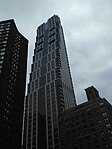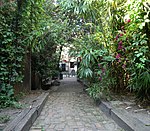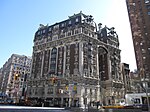Bradford Hotel (New York City)
1924 establishments in New York CityCultural history of New York CityHotel buildings completed in 1924Hotels established in 1924Hotels in Manhattan ... and 1 more
Upper West Side

The Bradford Hotel is a New York City establishment which opened on October 18, 1924, at 206 - 22 West 70th Street in Manhattan. It cost $2 million to build and was designed by George F. Pelham. It was owned by the Lapidus Engineering Company, the same firm that controlled the Hotel Oxford, which opened in 1923. The apartment hotel is sixteen stories and occupied a plot 150 by 100 between Broadway (Manhattan) and West End Avenue. It contains four hundred rooms., each with private bathrooms, kitchenettes, and many with terraces. It was being converted to a project for the elderly by January 1970.
Excerpt from the Wikipedia article Bradford Hotel (New York City) (License: CC BY-SA 3.0, Authors, Images).Bradford Hotel (New York City)
West 70th Street, New York Manhattan
Geographical coordinates (GPS) Address Nearby Places Show on map
Geographical coordinates (GPS)
| Latitude | Longitude |
|---|---|
| N 40.777416666667 ° | E -73.983527777778 ° |
Address
West 70th Street 210
10023 New York, Manhattan
New York, United States
Open on Google Maps









